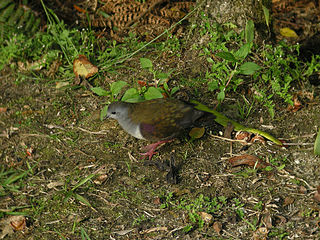
The island of Makira is the largest island of Makira-Ulawa Province in the Solomon Islands. It is third most populous island after Malaita and Guadalcanal, with a population of 55,126 as of 2020. The island is located east of Guadalcanal and south of Malaita. The largest and capital city is Kirakira.

The Tanna ground dove, also known as Forster's dove of Tanna, is an extinct dove species. Its taxonomic affiliation is uncertain but at its first scientific discussion by Johann Georg Wagler in 1829 it was classified into the genus Gallicolumba ; its closest relative is possibly the Santa Cruz ground dove. It was endemic to the Pacific island of Tanna, Vanuatu. Forster records a native name mahk, almost certainly from the Kwamera language.

Gallicolumba is a mid-sized genus of ground-dwelling doves which occur in rainforests on the Philippines. Local name 'punay' which is a general term for pigeons and doves. They are not closely related to the American ground doves genus. Rather, the present genus is closest to the thick-billed ground pigeon.

The white-throated ground dove is a species of ground dove in the genus Gallicolumba. It is classified as near-threatened.

The bronze ground dove is a species of bird in the family Columbidae.

The Polynesian ground dove or Society Islands ground dove or Tutururu is a critically endangered species of bird in the family Columbidae. Originally endemic to the Society Islands and Tuamotus in French Polynesia, it has now been extirpated from most of its former range by habitat loss and predation by introduced species such as cats and rats, and the species is now endemic only in the Acteon islands. The total population is estimated to be around 100-120 birds.
The Wetar ground dove is a species of bird in the family Columbidae found on Wetar, Indonesia, and on Timor. Its natural habitats are monsoon forests and gallery forests, and possibly woodland and bamboos. Threatened by habitat loss and hunting, the species is assessed as endangered by the IUCN.

The white-breasted ground dove, white-bibbed ground dove, or purple ground dove is a species of bird in the family Columbidae. It is found in New Guinea, the Bismarck Archipelago and the Solomon Islands. Its natural habitats are subtropical or tropical moist lowland forest and subtropical or tropical moist montane forest.

The white-fronted ground dove or Caroline Islands ground dove is a species of bird in the family Columbidae. It is endemic to Micronesia.

The Norfolk ground dove was a species of bird in the Columbidae, or pigeon family.
The Marquesan ground dove or Marquesas ground dove is a bird species in the family Columbidae. It is endemic to French Polynesia. Its natural habitats are subtropical or tropical dry forests and subtropical or tropical moist shrubland.
The Santa Cruz ground dove is a species of bird in the family Columbidae. It is found in the southern Solomon Islands and Vanuatu. Its natural habitat is subtropical or tropical moist lowland forests. It is threatened by habitat loss.

The Tongan ground dove, also known as the shy ground dove or friendly ground dove, is a species of bird in the family Columbidae. It is found in American Samoa, Fiji, Samoa, Tonga and Wallis and Futuna Islands. Its natural habitat is subtropical or tropical moist lowland forests. It is threatened by habitat loss.

The white-headed fruit dove is a species of bird in the pigeon family Columbidae. It was described by the English ornithologist John Gould in 1856, and the specific name eugeniae honours the French empress Eugénie de Montijo. Adults of the species have white heads, a purplish-red breast patch, a grey shoulder patch, olive-green upperparts, greenish underparts with a blue tinge, and a yellowish vent. Juveniles have green heads with the white restricted to the forehead and upper throat, a much smaller grey shoulder patch, and the red breast patch restricted to the centre of the breast.

The crested cuckoo-dove is a species of bird in the family Columbidae. It is endemic to the Solomon Islands archipelago. Its natural habitats are subtropical or tropical moist lowland forest and subtropical or tropical moist montane forest. It is threatened by habitat loss.
The Makira woodhen, also known as the Makira moorhen or kia, is a species of bird in the family Rallidae. It is endemic to the Solomon Islands. Its natural habitats are subtropical or tropical moist lowland forest and subtropical or tropical moist montane forest. It is critically endangered and sometimes considered extinct from habitat loss and predation by feral cats. The last recorded sighting was in 1953. Surveys in 2015–16 failed to find the species; though there were a number of reports of birds matching the description of the species from within the previous 10 years, the scientists concluded that the woodhen was likely extinct.

Pampusana is a mid-sized genus of ground-dwelling doves which occur in rainforests in the Pacific region. They are not closely related to the American ground doves.











